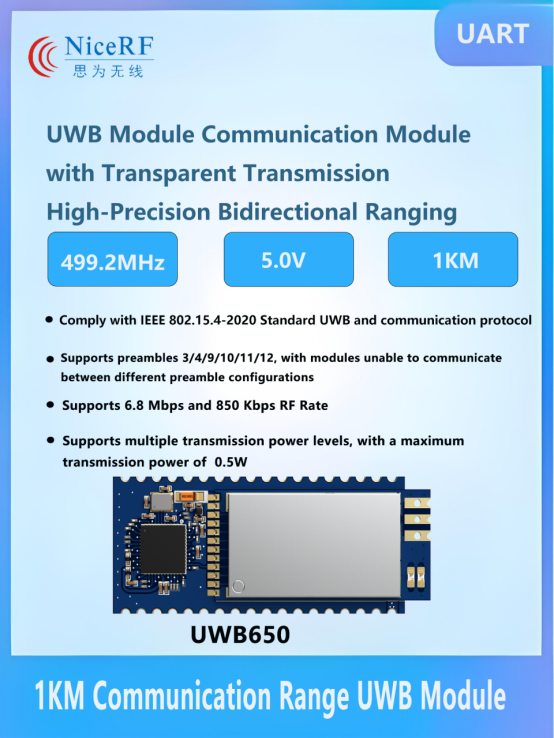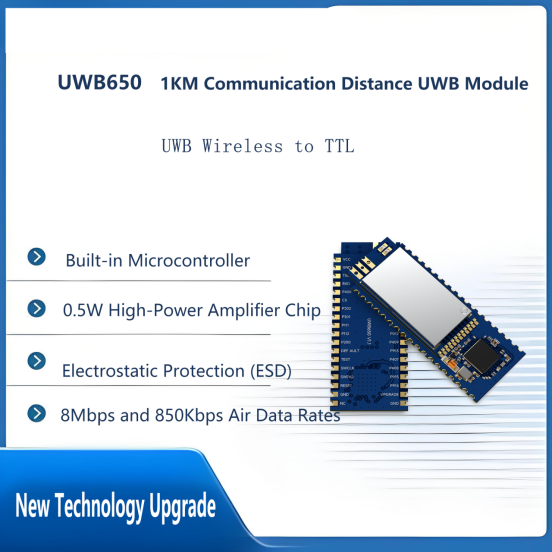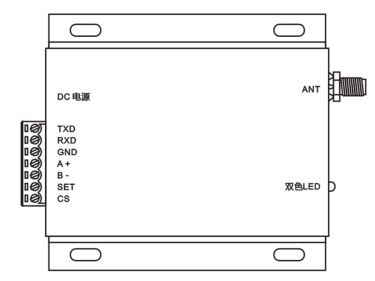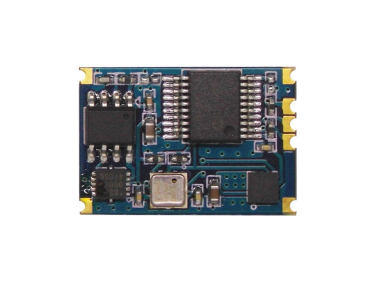「Knowledge Series」 A Detailed Exploration of the Advantages of UWB650 Precise Ranging and Positioning Technology
Aug . 2024
The UWB650 module is a newly released product by NiceRF, featuring two-way ranging and three-point planar positioning. The UWB650 module is developed based on the UWB3000F27 and comes equipped with a micro-controller, allowing users to use it directly without any configuration.
Following the IEEE 802.15.4-2020 standard, the UWB technology and its communication protocol offer high-precision, low-power, and low-latency wireless communication solutions, enabling accurate, energy-efficient, and fast wireless connections.
It supports UWB Channel 5 (6489.6 MHz), which offers excellent signal penetration and transmission stability, making it suitable for high-precision positioning and reliable data communication applications.
Air data rate transmission
Air data rate: Supports air data rates of 6.8 Mbps and 850 Kbps, offering a flexible choice between high-speed data transmission and low-speed, low-power communication, catering to different application scenarios.
Transmission rate: Communication is conducted in half-duplex mode, with a transmission rate of 1000 data packets per second, each with a maximum capacity of 1010 bytes. Sending and receiving data alternate, making this transmission method suitable for applications with high demands on data packet size and transmission rate, enabling efficient data exchange under reasonable bandwidth conditions.
Data transmission support: It supports AES-128 encryption technology to ensure the security of data transmission. When encryption is enabled, the maximum capacity of each data packet is reduced to 99 bytes to maintain efficient and secure data transmission under encryption. This encryption method effectively prevents data theft and tampering.
High-speed serial communication
The serial communication rate can reach up to 115200 bps, supporting high-speed data transmission. It meets the communication needs of most serial devices, ensuring stability and efficiency during data transmission.
Flexible Communication Management
Management is conducted through group IDs and device IDs. Each module is assigned a unique device ID and belongs to a specific group ID. The module can identify other modules within the same group via the group ID, enabling one-to-one or broadcast communication.
One-to-one communication: In one-to-one communication, data is transmitted only between the specific sender and receiver, ensuring the security and efficiency of directed communication.
Broadcast communication: In broadcast communication mode, data is transmitted to all modules within the same group, enabling multi-point synchronized communication. This flexible communication method is suitable for various complex network topology, supporting collaborative work and data sharing among multiple devices.
Ranging Function
Master-Slave Configuration (One Master to Five Slaves): One master can simultaneously measure the distance to up to five slave devices. This setup allows the master to efficiently manage and calculate the distances to multiple slave devices.
Ranging Principle: DS-TWR (Double-Sided Two-Way Ranging) measures the round-trip time of signals transmitted between the master and slave devices to accurately calculate the distance. The master sends a signal, the slave responds, and the master calculates the actual distance by measuring the signal's round-trip time. This method provides high-precision ranging, making it suitable for positioning and tracking applications.
Three-Point Planar Positioning Method: By measuring the distances between the target and three known reference points, precise positioning is calculated using the principles of triangulation.
Ranging Distance: Supports a maximum communication distance of 1 kilometer, with each ranging process taking approximately 25 milliseconds.
Positioning Function
Base Stations and Tags: Supports pairing one tag with three base stations, managing up to thirty tags. All tags can communicate with these three base stations.
Additional Features
The system supports upgrades via the serial port and allows for the configuration of various parameters to adjust settings according to specific needs.
Positioning Solution Comparison
Name | TOA | TDOA |
Ranging Time | Length | Short |
Power Consumption | Height | Low |
Hardware Requirements | Low | Extremely High |
Accuracy | Low | Height |
Interference Resistance | Height | Low |
Effective Area | Can still position outside the triangular range | Cannot position outside the triangular range |
Name | UWB650 | UWB3000F27 |
Interface | TTL | SPI |
Antenna Frequency | Channel 5(6489.6MHZ) | Channel 5(7987.2MHZ) |
Power Consumption | Height | Low |
Secondary Development | Customization
| Support |
There are several common positioning methods used in UWB positioning: Time Difference of Arrival (TDOA), Time of Flight (TOF) ranging, and Angle of Arrival (AOA). The first two methods can typically be used independently, while AOA is generally combined with TOF or TDOA for integrated positioning.
TOA (Time of Arrival) positioning is a crucial method in UWB technology. It calculates distance by measuring the time it takes for a wireless signal to travel from the transmitter to the receiver, thereby achieving positioning. TOA offers very high positioning accuracy and has strong interference resistance.
TDOA (Time Difference of Arrival) is a positioning method based on the difference in arrival times of signals. The system requires precise time synchronization, with extremely high accuracy. This places very high demands on the hardware, increasing the complexity of network maintenance and installation, which in turn raises costs.
AOA (Angle of Arrival) positioning typically calculates the arrival angle based on the phase difference of signals. It is generally not used independently. Since AOA involves angle resolution, the farther the distance from the base station, the lower the positioning accuracy if AOA is used alone.
TOF (Time of Flight) positioning is based on ranging, where the tag initiates distance measurements with each base station that needs to be located. After completing the ranging process, the position is calculated.
 +86-755-23080616
+86-755-23080616
 sales@nicerf.com
sales@nicerf.com
Website: https://www.nicerf.com/
Address: 309-314, 3/F, Bldg A, Hongdu business building, Zone 43, Baoan Dist, Shenzhen, China


 English
English









